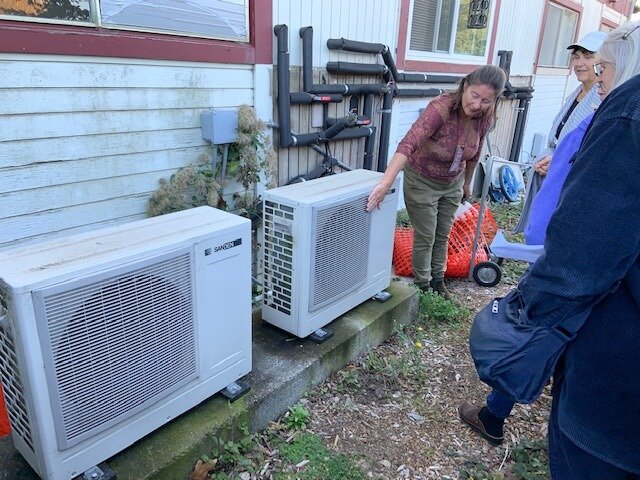Sustainable Stewardship
Ecological stewardship is woven into CLAM’s mission and plays an integral role in CLAM’s work. Here are some examples of energy-efficient solutions adopted by CLAM – from building practices to repairs and upgrades.
Tea time at the Passive House jobsite.
First New-Construction Passive House in California
In 2010, CLAM completed the first newly built home in California designed with “Passive House” standards for energy efficiency, thanks in part to the generous contributions of volunteer architects and builders.
Although many California homes have been remodeled to become “passive homes,” as described below, CLAM’s “Yellow House” was the first newly constructed home built on passive design principles in the state. Architects and builders came from across the state to see first-hand how CLAM was doing it.
Passive House is a highly energy-efficient building standard that also promotes indoor comfort and acoustic insulation. It was one of the pioneering concepts for building low-energy houses and is today a leading building standard.
Energy-Efficient Heat Pump Water Heaters
Heat pump water heaters are highly efficient, eco-friendly alternatives to conventional water heaters. Rather than relying on electricity or gas, heat pump water heaters pull heat from the surrounding air to heat the water. In other words, they move energy instead of generating it.
CLAM outfitted its first CLT home with a hybrid heat-pump water heater, one with an electric coil back-up. Overall, it uses 40% less energy than conventional water heaters.
In upgrading the water-heating system at CLAM’s Mesa Apartments in 2017, CLAM chose a heat-pump water heater without the electric coil backup. The SANCO2 heat-pump water heater supplies hot water for all the residents and the building’s laundry room, while using 70% less energy than traditional water heaters.
Ruth Lopez, CLAM's Program Manager, gives a tour of the water-heating system at CLAM's Mesa Apartments.
Hybrid heat-pump water heater at CLAM’s first CLT homeownership home.
Laundry-to-Landscape Grey Water System
In 2018, CLAM tenants and volunteers installed a laundry-to-landscape irrigation system at CLAM’s Mesa Apartments in Point Reyes Station. The system captures greywater from the drain hose of the building’s washing machine and sends it out to the garden. These systems can also send greywater into a sewer or septic system. This irrigation method is low cost and relatively easy to install. No permit is required to install a laundry-to-landscape system.
Soap Nuts
Ever heard of ‘em? Soap nuts are a biodegradable alternative to chemical laundry detergents. CLAM provides them for use by the residents in Mesa Apartments to keep their laundry-to-landscape greywater system providing chemical-free garden water.
CLAM’s Ruth Lopez oversees rain water system being installed as a demonstration project at the Little Yellow House building on the Point Reyes Commons.
Harvesting Rain Water
Harvesting rainwater reduces the energy and chemicals needed to treat water at central water-treatment facilities that is then transported to users. While lowering a household’s water bill, rainwater harvesting can also reduce strain on septic systems, reduce stormwater runoff, and help prevent erosion.







